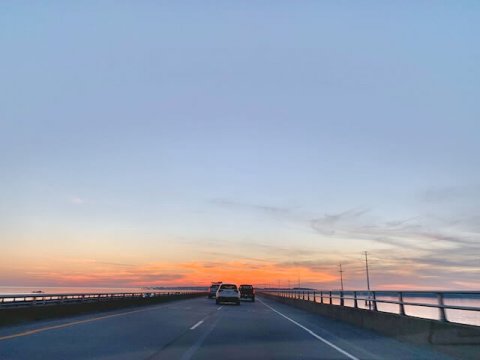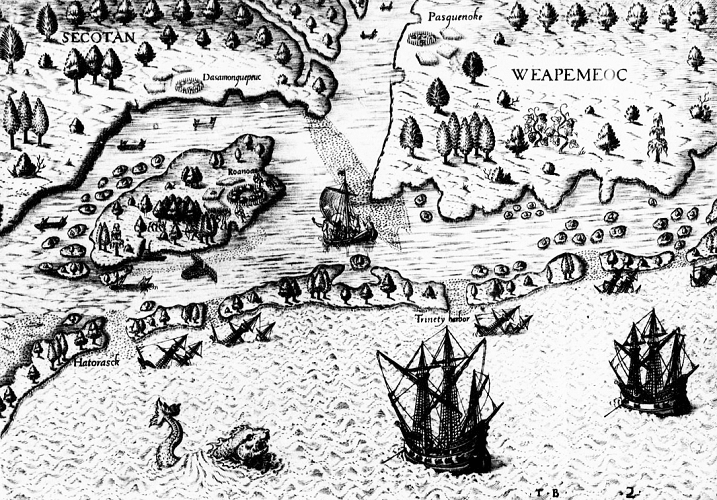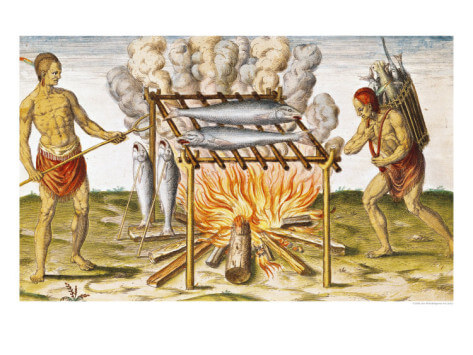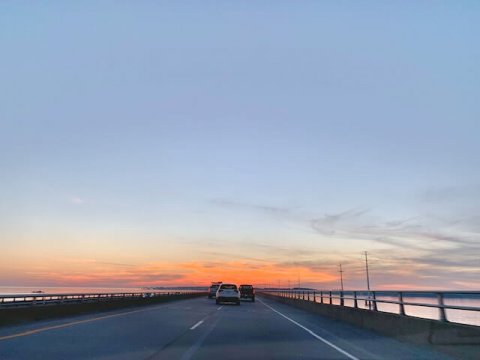How Roanoke Island’s Beginnings Paved the Way for the Tourism Industry

Tangled Vines and Troubled Times: How Roanoke Island’s rocky beginnings paved the way for a flourishing tourism industry
“Welcome to the Outer Banks” — Surely a refreshing sentiment after a long journey, this friendly message greets out-of-towners as they arrive over one of two bridges. Local hospitality is often noted as one of the reasons the OBX attracts more than five million visitors annually. Tourism has been the leading local industry for as far back as I can remember. Having lived here nearly all my life, I appreciate these happy travelers—especially for how they invigorate my beloved community. For about four decades, I’ve witnessed the steady rise in vacationers—along with businesses and services catering to them. It’s always so exciting when a new restaurant pops up--or I get an opportunity to check out one of the amazing Outer Banks rentals that vacationing friends have reserved. There's a sense of honor felt living here: a place so rich with history, nature, and recreational offerings. My children have been repeatedly reminded of the historical importance of our hometown, where the very first settlers from England became the Lost Colony. We try to visit local tourist attractions whenever possible, careful not to take our luck for granted. While appreciating the sights, I’ve been impressed with the kindness encountered, seeing sightseers helpfully accommodated wherever we go. This might be somewhat similar to the warm reception the very first excursionists received when they arrived on these shores in 1584, 1585, and again in 1587. By that time, the islands had already been settled for several centuries by branches of Carolina Algonquian tribes. The Roanoke and Croatoan natives were overjoyed to interact with the mysterious men, greeting them with warmth, hospitality, and lots of curiosity. The first of these brave Elizabethan voyagers were explorers and privateers, drawn to these islands with hopes of expanding their personal and patriotic fortunes. Their rave reviews of Roanoke Island piqued a lot of interest back home. Not only were merchants and politicians becoming interested in commercial potentials, but common folk were also beginning to dream of improved lives. By the third expedition, dozens of everyday, middle-class people had boarded one of three vessels, determined to be among the first permanent English settlers in the New World. I'm especially fascinated with the third of these Roanoke voyages, imagining my hometown was once a fabled land of promise. In those earliest days of discovery, this sandy land, albeit rich with maritime forests and beauty, was mainly just potential. What could have convinced so many to leave everything they knew behind...forever? Worse, the daunting journey took three months by boat—without accommodations on arrival or even assurance of a decent meal.
I'm especially fascinated with the third of these Roanoke voyages, imagining my hometown was once a fabled land of promise. In those earliest days of discovery, this sandy land, albeit rich with maritime forests and beauty, was mainly just potential. What could have convinced so many to leave everything they knew behind...forever? Worse, the daunting journey took three months by boat—without accommodations on arrival or even assurance of a decent meal.
 It’s easy to understand what draws visitors here nowadays, with a spectrum of enticements for every taste. Conversely, it’s hard for me to grasp what could be so alluring in the days before dinner buffets and the comforts of Outer Banks rentals. Digging through historical writings and theories from experts has helped me wrap my head around possible motivations, which vary significantly between epochs.
Four centuries ago, Europeans were enlightened about this region’s affluence of bountiful resources, including seafood, deer, wildfowl, sassafras, timber, and tobacco. These pioneers from the past lived in a period when their homeland suffered from severe dissonance and a vast separation of social classes. I understand a lot of the colonists (particularly those with wives and children) were promised land, more voice in government, and greater freedom of religion.
Settling here was a formidable undertaking back then. This was mainly because of powerful coastal storms, but also due to their own mediocre agricultural prospects. Natives had been cultivating this land for thousands of years, wielding ancient wisdom and superior, specialized skills for survival. The Algonquian extended countless courtesies to the colonists as they shared knowledge, food, and friendship, aiding their initial survival.
It’s easy to understand what draws visitors here nowadays, with a spectrum of enticements for every taste. Conversely, it’s hard for me to grasp what could be so alluring in the days before dinner buffets and the comforts of Outer Banks rentals. Digging through historical writings and theories from experts has helped me wrap my head around possible motivations, which vary significantly between epochs.
Four centuries ago, Europeans were enlightened about this region’s affluence of bountiful resources, including seafood, deer, wildfowl, sassafras, timber, and tobacco. These pioneers from the past lived in a period when their homeland suffered from severe dissonance and a vast separation of social classes. I understand a lot of the colonists (particularly those with wives and children) were promised land, more voice in government, and greater freedom of religion.
Settling here was a formidable undertaking back then. This was mainly because of powerful coastal storms, but also due to their own mediocre agricultural prospects. Natives had been cultivating this land for thousands of years, wielding ancient wisdom and superior, specialized skills for survival. The Algonquian extended countless courtesies to the colonists as they shared knowledge, food, and friendship, aiding their initial survival.
 Researchers theorize that across time, several indigenous tribes lived here only during the peak season (from early spring to early fall). They opted to move inland during cold and windy months. Prehistoric shell mounds have been found throughout this locality, remnants of feasts from far-gone days, ringing familiar today. I’ve been to more oyster roasts than I can count, but the discarded shells aren’t typically made into mountains anymore. (In recent years, however, they have been used to create “living shorelines” all along the coasts of North America.)
Like those seasonal, shellfish-shucking natives, most visitors find the summer months are most advantageous. Alternatively, I have a childhood friend who “winters” here every year. She’s the proud owner of one of the breathtaking oceanfront Outer Banks rentals nearby. I envy her arrangement of living locally part-time (when she nearly has the beaches to herself). When tourist season comes around, she again benefits from her wise investment. Plus, she hosts the best clam bakes!
Throughout the ages, seafood roasts and numerous other local recreations have endured. Hunting, fishing, boating, shelling, and birdwatching are just a few examples existing then and now. In the far past, however, the aim was more for function than fun. Presently, pursuits pumping even more adrenaline can be enjoyed, like kiteboarding, parasailing, air touring, surfing, and off-road ATV riding. I imagine a few of these may be replacements for the absence of some formerly fearsome aspects to travel.
Creative endeavors are ever-present, with evidence that artisans have lived here well before recorded history. Natives were skilled crafters of many things, such as boats, jewelry, woodcarvings, pottery, and baskets—traditional customs passed down generationally that continue to thrive today. Local businesses and markets could be comparable to the trading posts of yore, designated spots for presenting handmade wares.
I’ve often wondered about those initial venturers to these banks, reflecting on the breadth of differences between eras, in awe of common threads. With our modern world building up around sites of historical significance, I’m thankful that some traditions and landmarks have persevered. Some possibly extend even beyond the Elizabethan stage... like the Mother Vine.
Found on the soundside of Roanoke Island, this massive grapevine is believed to be the oldest, knowledgeably farmed vine in the country. It's uncertain who cultivated it, but most experts say it was likely indigenous peoples, long before colonization. During the first Roanoke voyage, it was noted grapes were so plentiful that “in all the world the like in abundance is not to be found.” The Algonquian were also said to have sipped on muscadine wine.
By the 1950s, the ancient vine had spread across two acres (though it’s since been scaled back). I’ve had the good fortune of sitting under these twisting twigs, nibbling on ripe scuppernongs. These sweet bursts of antiquity undoubtedly originated from the fruits that helped sustain the first English immigrants here, at least for a season.
Although those 16th-century migrants vanished without a trace, there are little reminders like these all over Roanoke Island. Street names honor the contributions and sacrifices they made, ultimately leading to the establishment of modern towns and monumental successes all over this new Old World. There are parallels between the two eras that cannot be missed if you dig just below the surface. What’s changed in the 400-plus years since are the size of the masses and the motives of the visitors... And now, there are far more year-round settlers.
Following the mysterious disappearance of the colonists of 1587, at least one generation passed before anyone from Europe attempted to call The Outer Banks home again. In short time, Bankers became the dominant inhabitants of the area. Their intentions were similar to their predecessors, but they had a lot less stacked against them. We’ll get to them in due course...
Tune in for the next installment...
-Michelle Leckie Davies
Read the First Installment of Michelle’s Series
Researchers theorize that across time, several indigenous tribes lived here only during the peak season (from early spring to early fall). They opted to move inland during cold and windy months. Prehistoric shell mounds have been found throughout this locality, remnants of feasts from far-gone days, ringing familiar today. I’ve been to more oyster roasts than I can count, but the discarded shells aren’t typically made into mountains anymore. (In recent years, however, they have been used to create “living shorelines” all along the coasts of North America.)
Like those seasonal, shellfish-shucking natives, most visitors find the summer months are most advantageous. Alternatively, I have a childhood friend who “winters” here every year. She’s the proud owner of one of the breathtaking oceanfront Outer Banks rentals nearby. I envy her arrangement of living locally part-time (when she nearly has the beaches to herself). When tourist season comes around, she again benefits from her wise investment. Plus, she hosts the best clam bakes!
Throughout the ages, seafood roasts and numerous other local recreations have endured. Hunting, fishing, boating, shelling, and birdwatching are just a few examples existing then and now. In the far past, however, the aim was more for function than fun. Presently, pursuits pumping even more adrenaline can be enjoyed, like kiteboarding, parasailing, air touring, surfing, and off-road ATV riding. I imagine a few of these may be replacements for the absence of some formerly fearsome aspects to travel.
Creative endeavors are ever-present, with evidence that artisans have lived here well before recorded history. Natives were skilled crafters of many things, such as boats, jewelry, woodcarvings, pottery, and baskets—traditional customs passed down generationally that continue to thrive today. Local businesses and markets could be comparable to the trading posts of yore, designated spots for presenting handmade wares.
I’ve often wondered about those initial venturers to these banks, reflecting on the breadth of differences between eras, in awe of common threads. With our modern world building up around sites of historical significance, I’m thankful that some traditions and landmarks have persevered. Some possibly extend even beyond the Elizabethan stage... like the Mother Vine.
Found on the soundside of Roanoke Island, this massive grapevine is believed to be the oldest, knowledgeably farmed vine in the country. It's uncertain who cultivated it, but most experts say it was likely indigenous peoples, long before colonization. During the first Roanoke voyage, it was noted grapes were so plentiful that “in all the world the like in abundance is not to be found.” The Algonquian were also said to have sipped on muscadine wine.
By the 1950s, the ancient vine had spread across two acres (though it’s since been scaled back). I’ve had the good fortune of sitting under these twisting twigs, nibbling on ripe scuppernongs. These sweet bursts of antiquity undoubtedly originated from the fruits that helped sustain the first English immigrants here, at least for a season.
Although those 16th-century migrants vanished without a trace, there are little reminders like these all over Roanoke Island. Street names honor the contributions and sacrifices they made, ultimately leading to the establishment of modern towns and monumental successes all over this new Old World. There are parallels between the two eras that cannot be missed if you dig just below the surface. What’s changed in the 400-plus years since are the size of the masses and the motives of the visitors... And now, there are far more year-round settlers.
Following the mysterious disappearance of the colonists of 1587, at least one generation passed before anyone from Europe attempted to call The Outer Banks home again. In short time, Bankers became the dominant inhabitants of the area. Their intentions were similar to their predecessors, but they had a lot less stacked against them. We’ll get to them in due course...
Tune in for the next installment...
-Michelle Leckie Davies
Read the First Installment of Michelle’s Series


